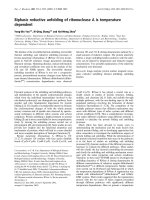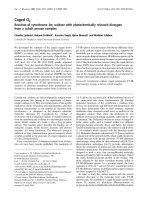Báo cáo y học: " Caenorhabditis elegans comes of age" pptx
Bạn đang xem bản rút gọn của tài liệu. Xem và tải ngay bản đầy đủ của tài liệu tại đây (48.97 KB, 3 trang )
Genome
BBiioollooggyy
2008,
99::
312
Meeting report
CCaaeennoorrhhaabbddiittiiss eelleeggaannss
ccoommeess ooff aaggee
Julian Ceron* and Peter Swoboda
†
Addresses: *Genetics and Functional Genomics Group, Molecular Biology and Biochemistry Research Center for Nanomedicine, CIBBIM,
Vall d’Hebron University Hospital, Networking Research Center on Bioengineering, Biomaterials and Nanomedicine (CIBER-BBN),
Barcelona, Spain.
†
Karolinska Institute, Department of Biosciences and Nutrition, Södertörn University College, School of Life Sciences,
Huddinge, Sweden.
Correspondence: Julian Ceron. Email:
Published: 16 June 2008
Genome
BBiioollooggyy
2008,
99::
312 (doi:10.1186/gb-2008-9-6-312)
The electronic version of this article is the complete one and can be
found online at />© 2008 BioMed Central Ltd
A report of the European
C. elegans
2008 meeting, Seville,
Spain, 29 March-2 April 2008.
In 1998, the publication of the genome sequence of Caeno-
rhabditis elegans (a first for metazoans) and the discovery
of RNA interference (RNAi) in this species provided a Big
Bang for research using this model organism. What has
happened since? Ten years later, scientists continue to
squeeze the excellent experimental features of this animal to
push the frontiers of knowledge forward in subjects as
diverse as genomics, aging, behavior and development. Such
breadth and variety was showcased at the recent European
C. elegans conference [ To
take just one example, as evidenced at the meeting, genomic
approaches often require validation that relies on genetics,
and single-gene studies in return locate the gene of interest
into larger functional networks. But the need to choose
between the whole and the detail is long gone these days,
because by now the ‘wood’ and the ‘trees’ are irreversibly
connected.
PPrroojjeeccttss iinn tthhee ppiippeelliinnee
High-throughput work was presented by Mihail Sarov (Max
Planck Institute, Dresden, Germany), who showcased the
TransgeneOme project, based on an alternative recombination
method for protein tagging. The TransgeneOme aims to
provide an open resource of tagged fosmid transgenes for
C. elegans at a genome-wide scale. The project is rolling and is
initially focusing on proteins involved in transcriptional
regulation as part of an international network, the
modENCODE project [], that
aims to identify all functional DNA sequence elements in the
C. elegans genome. Importantly, the TransgeneOme project
is open for other protein sets from C. elegans to be included
in their pipeline.
Mark Edgley (University of British Columbia, Vancouver,
Canada) reported on progress from the C. elegans Gene
Knockout Consortium in Canada and the USA. As a result of
the combined efforts of the Consortium, Shohei Mitani’s
group in Japan and the research community worldwide,
approximately one-quarter (around 5,000) of all C. elegans
genes has been knocked out, all of which are publicly
available via the Caenorhabditis Genetics Center website
[ This is a significant mile-
stone, and is a big step toward completing knockout
coverage for the entire genome. Denis Dupuy (University of
Bordeaux, France) explained the tasks that lie ahead for the
C. elegans Localizome project [i.
harvard.edu], which is based on expression-pattern studies
in transgenic animals carrying gene promotor-green fluores-
cent protein (GFP) fusion constructs. The next big hurdle to
overcome will be to expand the present-day small overlap
between the interactome (1,541 proteins) and the localizome
(1,610 gene promoters): only 48 gene/protein pairs are
present in both datasets. RNAi-induced modification of
expression patterns will be another way to expand the
Localizome project.
EEnnggiinneeeerriinngg tthhee ggeennoommee
Three presentations by members of Marcel Tijsterman’s
group (Hubrecht Institute, Utrecht, the Netherlands) pre-
sented different approaches to unraveling the mechanisms
controlling DNA double-strand breakage (DSB) and repair
in meiosis. Daphne Pontier described the generation of a
double-transgenic strain that allows the induction of DSB at
known genomic locations by controlling the expression of
the rare-cutting DNA endonuclease I-SceI through heat
shock. This strain is being used to identify novel players in
DSB repair/signaling pathways in genome-wide RNAi
screens, as reported by Wouter Koole. In an effort to develop
an efficient gene targeting method in C. elegans, Bennie
Lemmens explained how they are taking advantage of I-SceI
expressed in the germline in order to favor homologous
recombination between a given locus in the genome and a
transgenic DNA construct flanked by I-SceI target sites
(located on an extrachromosomal array) that is homologous
to the genome locus of interest. Marie Gendrel (Ecole
Normale Superieure, INSERM, Paris, France) presented a
successful application of homologous recombination using
the Mos1 transposon. Mos1-based insertional mutagenesis
led to identification of LEV-9 as a protein required for acetyl-
choline receptor clustering during signaling at the neuro-
muscular junction. Subsequently, she and her colleagues
exploited Mos1 using the MosTIC technique (Mos1 excision
induced transgene instructed gene conversion) to knock in a
T7 tag at the amino terminus of LEV-9. This tag made
inmunostaining easier and helped locate LEV-9 at the
neuromuscular junction.
GGeennee rreegguullaattiioonn iinn
CC eelleeggaannss
The recent completion of four genome sequences from
different Caenorhabditis species is helping Frederick
Partridge (University of Oxford, UK) to develop an intriguing
project about translational frameshifting in C. elegans. This
special regulatory mechanism of gene expression enables an
alternative reading of the genetic code by moving the
ribosome one base along the mRNA and thereby changing
the frame of translation. By comparing the four Caeno-
rhabditis genomes, Partridge has identified possible
conserved frameshifting sites. The availability of multiple
Caenorhabditis genomes also enables detailed analysis of
cis-regulatory control regions. Using reporter gene analysis,
Nuria Flames (Columbia University, New York, USA), has
defined the phylogenetically conserved cis-regulatory logic
of neuronal cell type specification. She defined a motif that is
required and sufficient to determine gene expression in
dopaminergic neurons and identified the ETS domain
transcription factor AST-1 as an activator of this motif.
Andre Furger (University of Oxford, UK) highlighted the
benefits of C. elegans to study transcription termination.
The existence of operons facilitates the exploration of
mechanisms that prevent premature transcription termina-
tion at the end of each gene within such a polycistronic unit.
Analyzing the coupling of 3’-end formation and transcription
termination at the end of transcription units, he and
colleagues found that transcription can continue for up to
0.8 kb downstream of poly(A) sites before cleavage and
transcription termination occurs. They also observed that
after cleavage at poly(A) sites, low levels of transcription can
continue to more than 1.5 kb downstream of the poly(A) site.
Considering the compact C. elegans genome, these findings
imply the existence of previously unknown overlapping
transcription units.
Helge Grosshans (Friedrich Miescher Institute, Basel, Swit-
zerland) reported a novel nuclear export route for micro-
RNAs (miRNAs). In vertebrates, Exportin-5 functions as an
exporter of miRNAs from the nucleus to the cytoplasm.
Grosshans described how the lack of an exportin-5 ortholog
in C. elegans guided their work toward the identification of a
new export complex in the nematode. Interestingly, by
working with a human cell line they observed how this novel
nuclear export route is conserved in vertebrates. Giana
Angelo (Fred Hutchinson Cancer Research Center, Seattle,
USA) shocked the audience by describing a hitherto
unreported adult diapause state that will certainly be deeply
studied in the following years. By using a different signaling
pathway from the one responsible for dauer formation, adult
worms are able to survive starvation for at least 30 days and
recover a functional germline when returned to food. Angelo
noted that entry into this adult diapause is dependent upon
the nuclear receptor NHR-49.
AAnn oolldd ccllaassssiicc nneevveerr ddiieess:: tthhee ggeenneettiicc ssccrreeeenn
Genetic screens have been developed from the very begin-
ning of C. elegans research. Still, the variety of strategies and
questions to be addressed seems unlimited in the minds of
worm scientists. Valeria Pavet (IGBMC, Strasbourg, France)
reported the characterization of a transdifferentiation event,
a process that directly transforms a rectal epithelial cell (Y)
into a motor neuron (PDA) without involving cell division.
She and colleagues have so far recovered 17 mutations from
a screen for genes affecting this transdifferentiation process.
Some of those mutants display a persistent Y cell that does
not transdifferentiate, others a loss of a recognizable Y cell
(as visualized with cell-type specific GFP fusions). This
screen will be a gold mine for elucidating the intermediate
cellular steps the Y cell goes through and for finding the
molecules governing the processes of transdifferentiation
and cell plasticity. As exemplified by Marie Silhankova
(Hubrecht Institute), genome-wide RNAi screens are
extremely powerful for uncovering gene function. She and
colleagues screened for enhancers of the Q neuroblasts
migration defect in mutants of the intracellular protein
trafficking complex termed the retromer. Q neuroblast
migration is regulated by the EGL-20/Wnt signaling
pathway. From the results of this screen, Silhankova
reported that members of the myotubularin family of lipid
phosphatases are required to produce the Wnt signal
involved in the migration of the neuroblasts. This role,
uncovered using an RNAi approach, was then confirmed by
using ‘real’ mutations.
A screen-in-waiting was presented by Philippa Mitchell
(University of Southampton, UK), who talked about
modeling alcohol dependence and tolerance, withdrawal and
/>Genome
BBiioollooggyy
2008, Volume 9, Issue 6, Article 312 Ceron and Swoboda 312.2
Genome
BBiioollooggyy
2008,
99::
312
relief from withdrawal behaviors in worms using ethanol
concentrations that are equivalent to those with effects in
humans. She and colleagues have dissected wild-type worm
behaviors in great detail and are now ready to use this
knowledge in screens to get at the genetics of behaviors
affected by alcohol.
The early publication of a genome sequence, RNAi, and the
efforts of public consortia generating powerful C. elegans
research tools (plus tens of years of hard and gifted work
beforehand) have transformed the worm into a ‘top model’
organism. Judging impact by the number of publications,
the increasing number of C. elegans labs around the world
and by the research presented at conferences like this one,
the worm is here to stay for good - feeding biomedical
research projects with vibrant and innovative ideas. It is
humbling to realize though that quite a bit of the work
described above was already envisaged by Sydney Brenner in
the early 1960s, before both the authors of this report were
born.
/>Genome
BBiioollooggyy
2008, Volume 9, Issue 6, Article 312 Ceron and Swoboda 312.3
Genome
BBiioollooggyy
2008,
99::
312







